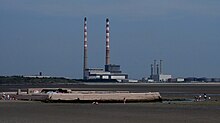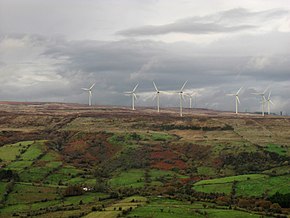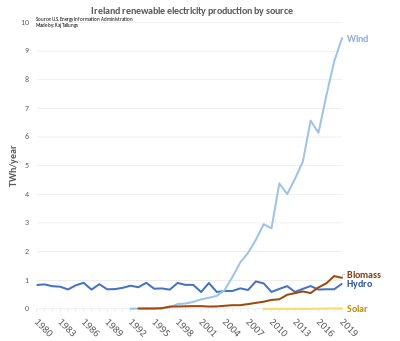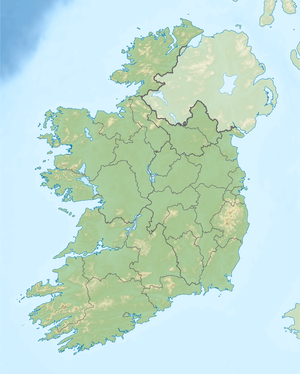Energy in Ireland

Ireland is a net energy importer. Ireland's import dependency decreased to 85% in 2014 (from 89% in 2013). The cost of all energy imports to Ireland was approximately €5.7 billion, down from €6.5 billion (revised) in 2013 due mainly to falling oil and, to a lesser extent, gas import prices.[1] Consumption of all fuels fell in 2014 with the exception of peat, renewables and non-renewable wastes.[1]
Final consumption of electricity in 2017 was 26 TWh, a 1.1% increase on the previous year. Renewable electricity generation, consisting of wind, hydro, landfill gas, biomass and biogas, accounted for 30.1% of gross electricity consumption.[2]
Energy-related CO2 emissions decreased by 2.1% in 2017 to a level 17% above 1990 levels. Energy-related CO2 emissions were 18% below 2005 levels.[2] 60% of Irish greenhouse gas emissions are caused by energy consumption.[3]
Historical Data[]
| Population (million) |
Prim. energy (TWh) |
Production (TWh) |
Export (TWh) |
Electricity (TWh) |
CO2-emission (Mt) | |
|---|---|---|---|---|---|---|
| 2004 | 4.06 | 177 | 22 | 162 | 25.1 | 41.4 |
| 2007 | 4.36 | 175 | 16 | 165 | 27.3 | 44.1 |
| 2008 | 4.44 | 174 | 18 | 167 | 27.9 | 43.8 |
| 2009 | 4.47 | 167 | 18 | 154 | 26.9 | 39.5 |
| 2012 | 4.58 | 154 | 21 | 145 | 26.1 | 34.9 |
| 2012R | 4.59 | 154 | 15 | 138 | 26.0 | 35.6 |
| 2013 | 4.60 | 152 | 26 | 144 | 26.2 | 34.4 |
| Change 2004-09 | 10.1% | -5.7% | -19.5% | -5.0% | 7.2% | -4.7% |
| Mtoe = 11.63 TWh, Prim. energy includes energy losses
2012R = CO | ||||||
Electricity[]
Final consumption of electricity in 2014 was 24 TWh. Electricity demand which peaked in 2008 has since returned to 2004 levels. Renewable electricity generation, consisting of wind, hydro, landfill gas, biomass and biogas, accounted for 22.7% of gross electricity consumption.[1]
The use of renewables in electricity generation in 2014 reduced CO2 emissions by 2.6 Mt. In 2014, wind generation accounted for 18.2% of electricity generated and as such was the second largest source of electricity generation after natural gas.[1]
The carbon intensity of electricity fell by 49% since 1990 to a new low of 457 g CO2/kWh in 2014.[1]
Ireland is connected to the adjacent UK National Grid at an electricity interconnection level of 9% (transmission capacity relative to production capacity).[5] In 2016, Ireland and France agreed to advance the planning of the Celtic Interconnector, which if realized will provide the two countries with a 700 MW transmission capacity by 2025.[6]
Primary energy sources[]
Natural gas[]
There have been four commercial natural gas discoveries since exploration began offshore Ireland in the early 1970s; namely the Kinsale Head, Ballycotton and Seven Heads producing gas fields off the coast of Cork and the Corrib gas field off the coast of Mayo.[7]
The main natural gas/Fossil gas fields in Ireland are the Corrib gas project and Kinsale Head gas field. Since the Corrib gas field came on stream in 2016, Ireland reduced its energy import dependency from 88% in 2015 to 69% in 2016.[8]
The Corrib Gas Field was discovered off the west coast of Ireland in 1996. Approximately 70% of the size of the Kinsale Head field, it has an estimated producing life of just over 15 years.[citation needed] Production began in 2015.[9] The project was operated by Royal Dutch Shell until 2018, and from 2018 onwards by Vermilion Energy.[10]
Peat[]
Ireland uses peat, a fuel composed of decayed plants and other organic matter which is usually found in swampy lowlands known as bogs, as energy which is not common in Europe. Peat in Ireland is used for two main purposes – to generate electricity and as a fuel for domestic heating. The raised bogs in Ireland are located mainly in the midlands.
Bord na Móna is a commercial semi-state company that was established under the Turf Development Act 1946. The company is responsible for the mechanised harvesting of peat in Ireland.[11]
Edenderry is the last peat fuelled power plant left operating in Ireland. Bord na Móna has been co-firing peat with biomass at Edenderry for more than 5 years.[11]
The West Offaly Power Station was refused permission to continue burning peat for electricity and was scheduled to close in December 2020.[12]
The National Parks and Wildlife Service (NPWS), under the remit of the Minister for Housing, Local Government and Heritage, deals with Special Areas of Conservation and Special Protection Areas under the Habitats Directive. Restrictions have been imposed on the harvesting of peat in certain areas under relevant designations.[11]
Coal[]
Coal remains an important solid fuel that is still used in home heating by a certain portion of households. In order to improve air quality, certain areas are banned from burning so-called 'smoky coal.' The regulations and policy relating to smoky fuel are dealt with by the Minister for the Environment, Climate and Communications.[13]
Ireland has a single coal-fired power plant at Moneypoint, Co. Clare which is operated by ESB Power Generation. At 915MW output, it is one of Ireland's largest power stations. The station was originally built in the 1980s as part of a fuel diversity strategy and was significantly refurbished during the 2000s to make it fit for purpose in terms of environmental regulations and standards. Moneypoint is considered to have a useful life until at least 2025.[13]
Oil[]
There have been no commercial discoveries of oil in Ireland to date.[7]
One Irish oil explorer is Providence Resources, with CEO Tony O'Reilly, Junior and among the main owners Tony O'Reilly with a 40% stake.[14]
Renewable Energy[]


Under the Renewable Energy Directive Ireland has set a target of producing 16% of all its energy needs from renewable energy sources by 2020. Between 2005 and 2014 the percentage of energy from renewable energy sources grew from just 3.1% to 8.6% of total final consumption.
The country has a large and growing installed wind power capacity at 4,351 MW by the end of 2020 producing 38% of all its electricity needs in that year.[15] In contrast in 2019 it had the second lowest installation of solar PV power in the EU after Latvia at just 36 MW of installed capacity.[16]Wind[]

As of 2020 Ireland has 5510 megawatt and the Republic of Ireland has 4235 MW of installed wind power nameplate capacity.[17]
In 2020 wind turbines generated 36.3% of Ireland's electrical demand, one of the highest wind power penetration in the world.[18][19]
Ireland's 250 wind farms (368 all-island),[17][20] are almost exclusively onshore, with only the 25 MW Arklow Bank Wind Park situated offshore as of 2020.
Ireland's instantaneous wind power generation fluctuates between near zero and 3,347 MW[17] due to weather,[21] with an average capacity factor of 32.3% in 2015.[22] Irish wind power generation is higher during winter and lower in the summer.[23]
Ireland uses an EU industry subsidy known as the Public Service Obligation to support development of wind and other domestic power generation,[24] currently levied at €72 per year per household.[25] In the 2016/17 period, €308 million raised through this levy was planned to be granted to supporting domestic renewable energy schemes. €120.90 million was planned to be granted to peat generation.[26]
Concerns over energy security (Ireland lacks fossil fuel resources, and has extensive wind resources), climate change mitigation policies, and compliance with EU Directives for market liberalisation, have all shaped wind power development in IrelandWood[]
The Department of Agriculture, Food and the Marine have responsibility for the Forest Service and forestry policy in Ireland. Coillte (a commercial state company operating in forestry, land based businesses, renewable energy and panel products) and Coford (the Council for Forest Research and Development) also fall under that Department's remit.
Wood is used by households that rely on solid fuels for home heating. It is used in open fireplaces, stoves and biomass boilers.
In 2014, the Department produced a draft bioenergy strategy. In compiling the strategy, the Department worked closely with the Department of Agriculture in terms of the potential of sustainable wood biomass for energy purposes.[27]
Energy storage[]
The utility ESB operates a pumped storage station in Co. Wicklow called Turlough Hill with 292 MW peak power capacity.[28] A Compressed air energy storage project in salt caverns near Larne received €15m of funding from EU. It won a further €90m from the EU in 2017 as a project of common interest (PCI).[29] It was intended to provide a 250-330 MW buffer for 6–8 hours in the electricity system.[30] This project has since been cancelled due to the company in charge of the project, Gaelectric, entered administration in 2017.[29]
Energy policy[]
The Department of the Environment, Climate and Communications oversees the formulation and implementation of policies concerning Ireland's coal, gas, peat, oil, electricity and renewable energy supply. The department strives to protect Ireland's energy supply, generation, security, affordability and sustainability, and to ensure that Ireland complies with international energy and climate change policies.[31]
Carbon Tax[]
The Minister for Finance introduced, with effect from 1 May 2013, a solid fuel carbon tax (SFCT). The Revenue Commissioners have responsibility for administering the tax. It applies to coal and peat and is chargeable per tonne of product.[11]
National Energy Targets[]
Ireland has set a national target to reduce energy demand by 20% of the historic average energy use during the period 2000–2005 through energy efficiency measures. The current suite of measures is described in detail in Ireland's National Energy Efficiency Action Plan (NEEAP) and annual reports. A binding EU target for renewable energy use is also established. 16% of final energy use and 10% of energy use in the transport sector must be derived from renewable sources by 2020. In order to achieve Ireland's overall renewable energy target, national sub-targets have also been set in the end-use sectors of heat (12%) and electricity (40%). Ireland, along with Denmark and Luxembourg, has the most challenging target for greenhouse gas emissions reductions in the EU; Ireland's target is to achieve 20% lower than the 2005 greenhouse gas emissions levels by 2020. Achieving Ireland's energy targets will help meet its binding EU greenhouse gas emissions target in heat and transport, but does not guarantee it. Emissions targets also include emissions from agriculture and waste disposal; such emissions currently account for 35% of Ireland's greenhouse gas emissions, with energy-related emissions accounting for the remainder.[32]
Progress Towards Targets[]
Ireland is, on average, just over half way towards meeting its 2020 renewable energy target, with 8.6% of gross final consumption derived from renewables in 2014.[32]
The contribution of renewables to gross final consumption (GFC) was 8.6% in 2014. This compares to a target of 16% to be achieved by 2020. This avoided 3.3 million tonnes of CO
2 emissions and €346 million of fossil fuel imports.[1]
The average emissions of new cars purchased in 2014 was 117.5 g CO2/km, which is below the EU target for car manufacturers of 130 g CO2/km to be reached by 2015.[1]
Energy-related CO
2 emissions in those sectors outside the EU Emissions Trading Scheme (which covers transport, heating in households, buildings and small industry) were 21% below 2005 levels in 2014.[1]
Since 2003 approximately 190 wind farms, connected across 24 counties, have been installed, equating to 2,375 MW of renewable electricity capacity. These wind farms have been instrumental in driving achievement of 22.7% renewable penetration by end 2014.[32]
Between 200 MW and 250 MW of additional wind capacity must be installed every year to 2020. Approximately 270 MW of wind capacity was installed in 2014. Average installed capacity over the last five years has been 177 MW.[32]
Sustainable Energy Authority of Ireland (SEAI)[]
The Sustainable Energy Authority of Ireland (SEAI) was established as Ireland's national energy authority under the Sustainable Energy Act 2002. SEAI's mission is to play a leading role in transforming Ireland into a society based on sustainable energy structures, technologies and practices. To fulfil this mission SEAI aims to advise the Government, and deliver a range of programmes aimed at a wide range of stakeholders.[33]
Nuclear energy[]
The Single Electricity Market encompassing the entire island of Ireland does not, and has never, produced any electricity from nuclear power stations. The production of electricity for the Irish national grid (Eirgrid), by nuclear fission, is prohibited in the Republic of Ireland by the Electricity Regulation Act, 1999 (Section 18).[34] The enforcement of this law is only possible within the borders of Ireland, and it does not prohibit consumption. Since 2001 in Northern Ireland and 2012 in the Republic, the grid has become increasingly interconnected with the neighbouring electric grid of Britain, and therefore Ireland is now partly powered by overseas nuclear fission stations.[35][36]
A ‘Eurobarometer’ survey in 2007 indicated that 27 percent of the citizens of Ireland were in favour of an “increased use” of nuclear energy.[37]
As of 2014, a Generation IV nuclear station was envisaged in competition with a biomass burning facility to succeed Ireland's single largest source of greenhouse gases, the coal burning Moneypoint power station, when it retires, c. 2025.[38][39]
In 2015 a National Energy Forum was founded to decide upon generation mixes to be deployed in the Republic of Ireland,[40]
out to 2030. This forum has yet to be convened (Oct 2016).See also[]
- Electricity sector in Ireland
- Renewable energy in the Republic of Ireland
- List of power stations in the Republic of Ireland
- Renewable energy by country
| Wikimedia Commons has media related to Energy in Ireland. |
References[]
- ^ Jump up to: a b c d e f g h "Energy in Ireland 1990-2014" (PDF). Energy in Ireland 1990-2014. SEAI. 2015. Archived from the original (PDF) on 13 April 2016. Retrieved 25 May 2016.
- ^ Jump up to: a b "Energy In Ireland 2018" (PDF). SEAI. 2018.
- ^ SEAI. 2019 https://www.seai.ie/data-and-insights/seai-statistics/key-statistics/co2/. Missing or empty
|title=(help) - ^ IEA Key World Energy Statistics Statistics 2015, 2014 (2012R as in November 2015 + 2012 as in March 2014 is comparable to previous years statistical calculation criteria, 2013, 2012, 2011, 2010, 2009 Archived 7 October 2013 at the Wayback Machine, 2006 Archived 12 October 2009 at the Wayback Machine IEA October, crude oil p.11, coal p. 13 gas p. 15
- ^ COM/2015/082 final: "Achieving the 10% electricity interconnection target" Text PDF page 2-5. European Commission, 25 February 2015. Archive Mirror
- ^ "President Hollande and An Taoiseach Kenny agree €1 billion Ireland-France Electricity Interconnector". 4coffshore.com. 21 July 2016. Retrieved 8 August 2016.
- ^ Jump up to: a b "Oil and Gas (Exploration & Production)". Oil and Gas (Exploration & Production). Department of Communications, Energy & Natural Resources. 2015. Retrieved 25 May 2016.
- ^ "Energy in Ireland 1990-2016. 2017 Report" (PDF). Sustainable Energy Authority of Ireland. December 2017. p. 4. Retrieved 9 October 2018.
- ^ Murtagh, Peter (30 December 2015). "Natural gas begins flowing from controversial Corrib field". The Irish Times. Retrieved 1 January 2020.
- ^ Falconer, Kirk (3 December 2018). "Shell Completes $1.3 bln sale of Corrib gas field stake to CPPIB". PE Hub. Retrieved 1 January 2019.
- ^ Jump up to: a b c d "Peat". Department of Communications, Climate Action & Environment. Retrieved 9 October 2018.
- ^ Kathleen O'Sullivan "West Offaly Power Station closure: ‘A final plea to ensure reason and sense prevails’" AgriLand, Dec 11, 2020.
- ^ Jump up to: a b "Coal". Department of Communications, Climate Action & Environment. Retrieved 9 October 2018.
- ^ Irish oil find expected to yield 280m barrels of oil, Ireland's first offshore oilfield will yield much more oil than expected, Providence Resources said The Guardian 10 October 2012
- ^ "Wind energy in Europe in 2020 - Trends and statistics". WindEurope. Retrieved 25 February 2021.
- ^ webmaster. "Photovoltaic barometer 2020 | EurObserv'ER". Retrieved 1 June 2020.
- ^ Jump up to: a b c "Wind Statistics". iwea.com. 18 June 2020. Retrieved 18 June 2020.
- ^ "Wind Energy Powers Ireland to Renewable Energy Target". 28 January 2021.
- ^ Eoin Burke-Kennedy (27 December 2015). "Over 23% of electricity demand now supplied through wind". The Irish Times. Retrieved 2 January 2016.
- ^ "Ireland's Clean Energy Hits Record Output". Irish Wind Energy Association. 7 January 2015. Retrieved 29 January 2015.
- ^ "Wind Record Broken". EirGrid. Retrieved 21 January 2017.
- ^ "Fuel Mix Disclosure and CO2 Emissions 2015" (PDF). Commission for Energy Regulation. 26 August 2016. p. 10. Retrieved 21 January 2017.
- ^ "All-island Wind and Fuel Mix summary, 2014" (PDF). Eirgrid. Archived from the original (PDF) on 22 July 2015.
- ^ "Public Service Obligation Levy 2015/2016" (PDF). Commission for Energy Regulation.
- ^ "Electricity bills to rise as regulator increases PSO charge". The Irish Times. 1 August 2016. Retrieved 10 August 2016.
- ^ "Public Service Obligation Levy 2016/17 — Proposed Decision Paper" (PDF). Commission for Energy Regulation. 31 May 2016. Retrieved 6 December 2016.
- ^ "Solid Fuels | Solid Fuel Heating Ireland". Wood. Department of Communications, Energy and Natural Resources. 2015. Retrieved 25 May 2016.
- ^ "Turlough Hill". ESB Archives. 1 March 2015. Retrieved 12 February 2020.
- ^ Jump up to: a b "Larne CAES plans withdrawn - Modern Power Systems". www.modernpowersystems.com. Retrieved 16 October 2020.
- ^ "Gaelectric to get €8.3m EU funds for energy storage project". The Irish Times. 1 August 2016. Retrieved 10 August 2016.
- ^ "Energy Department of Communications, Climate Action and Environment". Energy. Department of Communications, Energy and Natural Resources. 2015. Retrieved 25 May 2016.
- ^ Jump up to: a b c d "Ireland's Energy Targets" (PDF). Sustainable Energy Authority of Ireland. SEAI. April 2016. Retrieved 25 May 2016.
- ^ "About Us". Sustainable Energy Authority Of Ireland. Retrieved 11 May 2021.
- ^ "Electricity Regulation Act, 1999 (Section 18)". www.irishstatutebook.ie.
- ^ "That nukes that argument". 7 June 2013.
- ^ https://web.archive.org/web/20140721003556/http://www.dcenr.gov.ie/NR/rdonlyres/DD9FFC79-E1A0-41AB-BB6D-27FAEEB4D643/0/DCENRGreenPaperonEnergyPolicyinIreland.pdf page 50
- ^ "Ireland Rejects Uranium Prospecting Applications". www.nucnet.org.
- ^ "Emerging Nuclear Energy Countries". World Nuclear Association. April 2009. Retrieved 22 April 2009.
- ^ https://web.archive.org/web/20140721003556/http://www.dcenr.gov.ie/NR/rdonlyres/DD9FFC79-E1A0-41AB-BB6D-27FAEEB4D643/0/DCENRGreenPaperonEnergyPolicyinIreland.pdf page 50 to 60
- ^ "Ireland's Transition to a Low Carbon Energy Future 2015-2030" (PDF). Retrieved 30 July 2016.
- Energy in Ireland
- Department of the Environment, Climate and Communications
